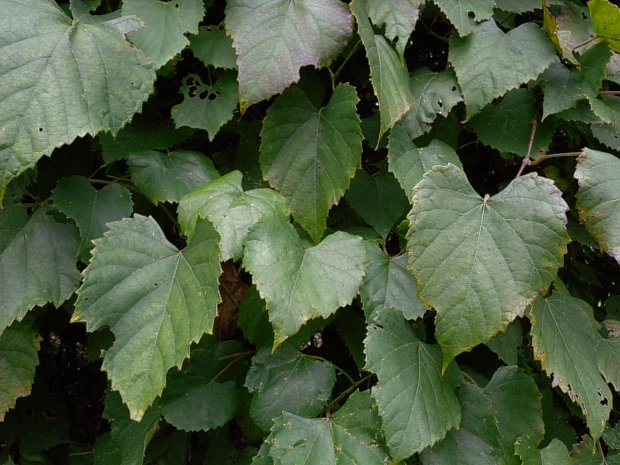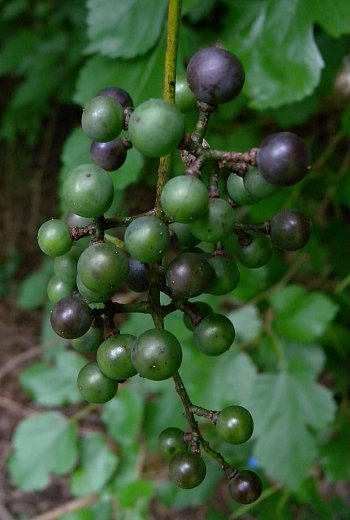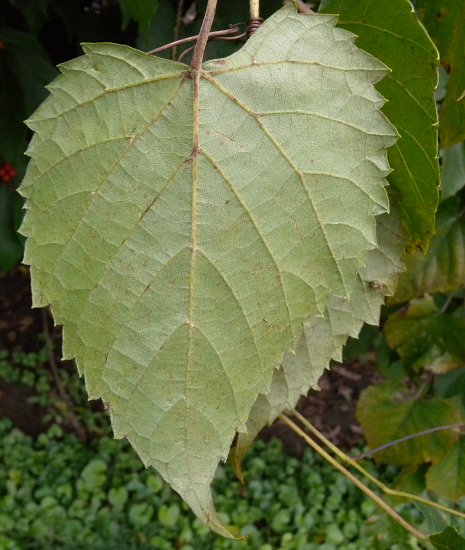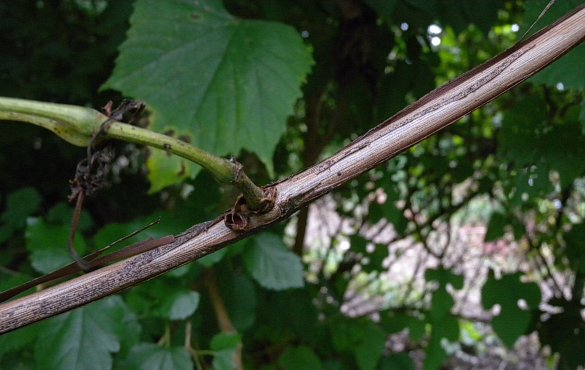
Panicles of yellowish green flowers up to 7" long and 3½" across are occasionally produced; these panicles are narrowly pyramidal in shape, although they often nod or hang downward from their peduncles (basal stalks). The flowers can be perfect or unisexual (either male or female); individual flowers are about 3 mm. (1/8") across. Each perfect flower has 5 petals that are early-deciduous, an insignificant calyx that has been reduced to a flat disk, 5 stamens with white filaments and yellow anthers, and a pistil. Male flowers lack pistils, while female flowers lack fully developed stamens, otherwise they are the same as perfect flowers. The branches and pedicels of panicles are light green or yellowish green, glabrous or finely hairy, and terete. The peduncles are 1-6" long; they are similar to the branches and pedicels of panicles in their characteristics. The blooming period occur from late spring into early summer, lasting about 1-2 weeks. The flowers have a strong sweet fragrance. Afterwards, panicles with perfect or female flowers are replaced by berries, although it is not uncommon for these fruits to abort. Initially, these berries are small and green, but they become dark blue-violet or black and 6-8 mm. across at maturity during the autumn. Mature berries are globoid in shape and they may, or may not, have a glaucous bloom. The interior of these berries is juicy with a sour to sweet-tart flavor; they become sweeter after there has been a light frost. Each berry contains about 2-4 seeds; individuals seeds are grayish brown to dark brown, ovoid in shape, and 3-5 mm. long. The root system is woody and spreading. This vine reproduces by reseeding itself.

Cultivation: The preference is full sun to light shade, moist to mesic conditions, and a fertile loamy soil, although other soil types are tolerated. This woody vine can become aggressive, climbing over shrubs and small trees and killing them. It is winter cold-hardy to about Zone 4 or Zone 5 in North America, as defined by the USDA.
Range & Habitat: The native Frost Grape (Vitis vulpina) is occasional throughout Illinois, although it is slightly less common in the northern one-third of the state than elsewhere (see Distribution Map). Habitats include floodplain woodlands, banks of rivers and streams, woodland openings, woodland borders, thickets, and fence rows. Disturbance that reduces the overhead canopy of trees encourages the development of this vine because of the increased levels of light. It is an early colonizer of such disturbance-caused openings.

Faunal Associations: In general, the value of Frost Grape (Vitis vulpina) and other wild grapes (Vitis spp.) to wildlife is quite high. Robertson (1929) observered honeybees, bumblebees, and long-horned bees (Eucera spp.) visiting the flowers of these woody vines, where they collected primarily pollen. Other insects feed on the leaves, suck the plant juices, bore through the wood, and feed on other parts of these woody vines. This latter group of insects include the larvae of long-horned beetles, leaf beetles, weevils, scarab beetles, larvae of gall flies, plant bugs, stink bugs, leafhoppers, treehoppers, aphids, the Grape Phylloxera (Daktulasphaira vitifoliae), armored scales, mealybugs, thrips, the Giant Walkingstick (Megaphasma denticrus), and the larvae of many moths, including Geometer moths, leaf blotch miner moths (Gracillariidae), shield-bearer moths (Heliozelidae), owlet moths (Noctuidae), Sphinx moths, and window-winged moths (Thyrididae); see the Insect Table for more information. Insectivorous birds benefit from the abundant insects that feed on, or find hiding places in, these woody vines. The fruits of Frost Grape and other wild grapes are also a popular source of food for many birds, such as tanagers, crows, blackbirds, orioles, woodpeckers, thrushes, vireos, some sparrows, and some warblers; see the Bird Table for more information. Many birds also use these woody vines for protective cover and nesting sites. The fruits of wild grapes are eaten by various mammals, including the Gray Fox, American Red Fox, Virginia Opossum, Striped Skunk, Prairie Spotted Skunk, Raccoon, Fox Squirrel, and American Black Bear (Martin et al., 1951/1961; Beeman & Pelton, 1980). Their fruits are also eaten by the Eastern Box Turtle, while their foliage, stems, and twigs are eaten by the Domestic Goat and White-tailed Deer (Ernst et al., 1994; Blackmore, 1998; Sokala & Kirkpatrick, 1973).

Photographic Location: Along a fence row near the edge of a woodland at Crystal Lake Park in Urbana, Illinois.
Comments: The Frost Grape (Vitis vulpina) is one of several native wild grapes that can be found in Illinois. It can be distinguished from similar species of grapes (Vitis spp.) primarily by the lack of significant lobes on most of its leaves, and its leaf undersides are either hairless or they have hairs along the primary veins only. Frost Grape could be confused with Raccoon Grape (Ampelopsis cordata), however the latter species has branchlets with uninterrupted pith, branchlets with tight bark, undivided tendrils, and panicles of fruits that are as wide or wider than they are long. In contrast, wild grapes have branchlets with interrupted pith, branchlets with loose and shredded bark, divided tendrils, and panicles of fruits that are longer than they are across. Frost Grape also has wider diaphragms at the nodes of its branchlets (where the pith is interrupted) as compared to the similar Riverbank Grape (Vitis riparia); the diaphragms of Frost Grape are 2-5 mm. across, while the diaphragms of Riverbank Grape are 0.5-1.5 mm. across. The teeth along the leaf margins of Riverbank Grape tend to more acute, and its leaves are more likely to have significant lobes. Other common names of Vitis vulpina include Fox Grape and Chicken Grape. However, Fox Grape more often refers to another species of grape, Vitis labrusca. The range of this latter species occurs to the east of Illinois. An obsolete scientific name for the Frost Grape is Vitis cordifolia.